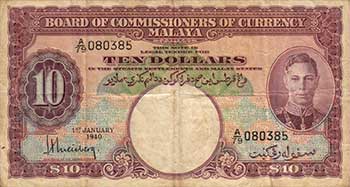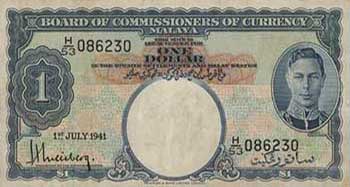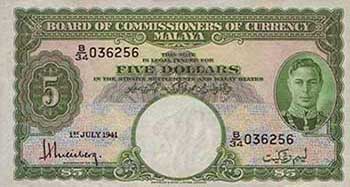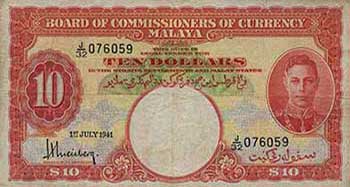Malaya Paper Money Issues: 1940-1941

The Board of Commissioners of Currency of Malaya printed an issue of paper money in 1940 with denominations of 1 , 5 and 10 Dollars. The colours of these banknotes were green, blue, and purple, respectively. All of these banknotes were printed in the United Kingdom and then transported to Penang in what was then Malaya but is now Malaysia.
The 10 Dollar notes arrived without mishap which cannot be said for the 1 or 5 dollar notes. Their fate was far different.



Of the 27 million 1 dollar and 5.6 million 5 dollar notes planned for circulation some 500,000 1 dollar and 100,000 5 dollar notes were lost when the cargo ship the the SS Eumanes was sunk. In November of 1940 the cargo ship SS Automedon encountered the German raider Atlantis and came under fire, the first shells hitting the bridge of the SS Automedon killing its captain and all of its officers. On board were 700,000 1 dollar notes and 500,000 5 dollar notes. The manifest also included crated aircraft, motor vehicles, spare parts, alcohol, cigarettes and several food products including frozen produce. The biggest find, however, were the top secret maps and codes and above all a bag marked "highly confidential", with multiple punctures so that it could sink in case of a devastating attack. Within were documents pin-pointing positions of all allied troops in the Asia area, including additional details outlining exactly what would happen from a British point of view should Japan enter the war on the axis side. Details of Australian and New Zealand force deployment and future plans were also present. Located and removed from the ship by a boarding party from the Atlantis, the information was then sent to the German Embassy in Japan and later the Japanese were given copies, while the originals were hand carried to Berlin for verification. The axis powers were very wary of the information at first, puzzled that such important documents were being carried on a virtually defenseless ship. Berlin verified the documents as genuine and later Japan would act upon the information. This information was instrumental in the Japanese planning its assault on the Malay peninsula and subsequently the relevant ease with which they were able to take Singapore.
It is not known if any of the notes were taken at the time of boarding the Automedon, which was sent to the bottom by scuttling charges laid by the Germans when they determined the ship was too badly damaged to tow. When news of this incident reached the British, they almost immediately they halted the release of the 1 and 5 Dollar banknotes, releasing only the 10 Dollar note in mid 1941. New paper money with different colours were then produced. The 1 and 5 Dollar notes swapped colours the 1 Dollar was now blue, the 5 Dollar green, and the 10 Dollar was changed to red. However, a brown version also exists. The popular conclusion is that the brown 10 was removed from circulation at the time of Pearl Harbour. As of 2012 there is only 1 known example of this note to exist so its existence is bound to remain a mystery. It is very possible the Japanese were able to seize all of the brown 10 Dollar notes when Penang was taken in 1942. The banknotes with denominations of 1, 5 and 10 (the red version) dated the 1st of July, 1941, did not actually circulate until 1945. The purple 10 Dollar note was still redeemable until 1948.



Today the 1940 1 and 5 Dollar Malayan banknotes are extremely rare and command five figure sums, whether as specimens or as potentially circulation notes. The 5 Dollar banknote is by far the rarest. The purple 10 Dollar note is also somewhat scarce but possible to collect. The brown 10 Dollar (unlisted in the Standard Catalog of World Paper Money) has not been offered for sale in recent times. The notes dated 1941 are relatively common and collectable, the 5 Dollar bill surprisingly being the scarcest of the three and commanding a higher price, relative to its counter parts in similar condition.





